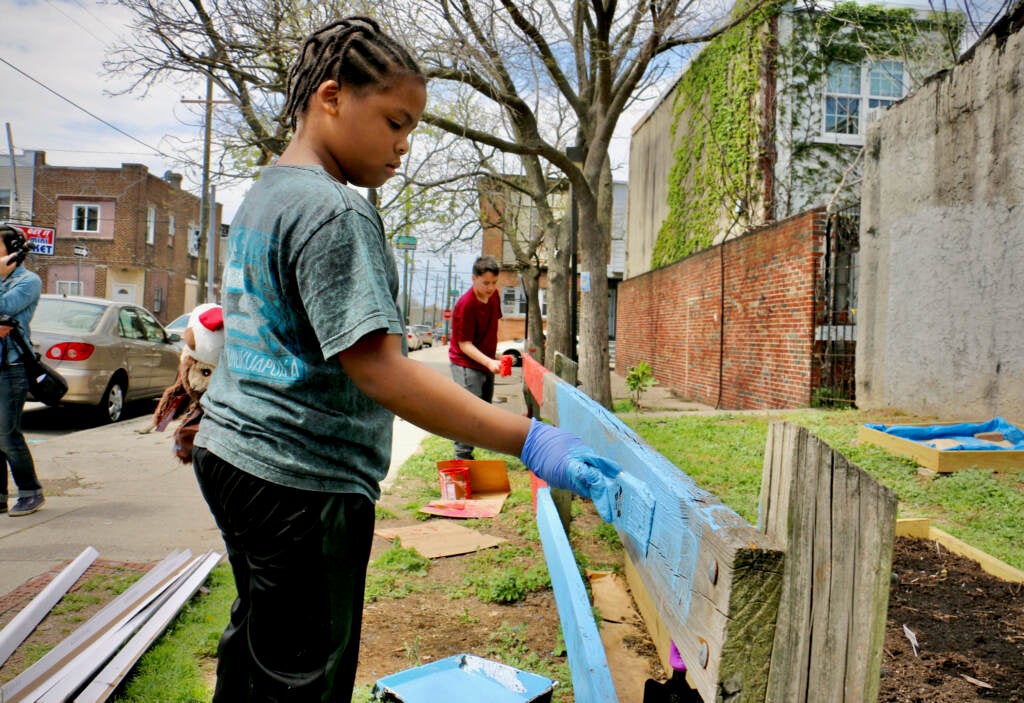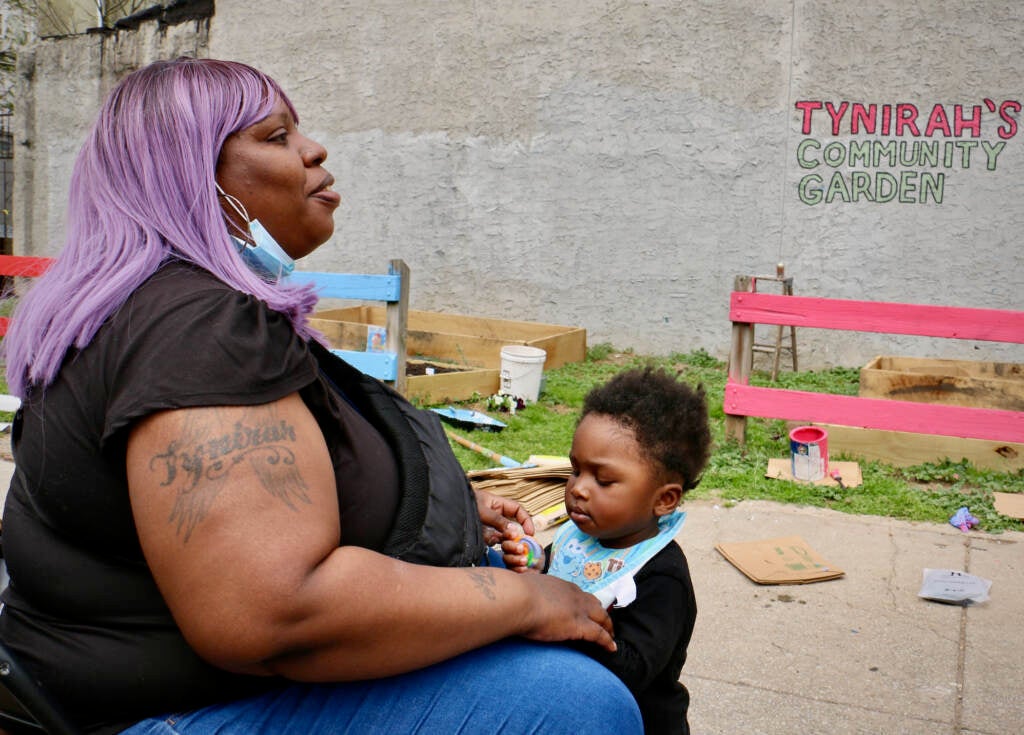Could planting gardens be the key to preventing shootings? These Grays Ferry residents are giving it a go
Many Philadelphia residents are pitching in to reduce blight this spring, some with the goal of making neighborhoods safer.
Listen 5:43
Tyrique Glasgow helps 7-year-old Ryan Penson get started with a paint roller at Tynirah's Community Welcome Garden in Gray's Ferry. (Emma Lee/WHYY)
Ryan, 7, smears a thick, sloppy stroke of bright pink paint over a newly constructed wooden fence at the Tynirah Borum Community Welcome Garden as her twin sister, Riley, cries out for a tissue. In their enthusiasm, both girls have dripped paint onto their white sneakers.
“Sometimes as adults we have to fill in the blanks for them,” says Tyrique Glasgow as he starts in on a touch-up coat.
Glasgow runs a nonprofit called the Young Chances Foundation, and he’s leading the charge on the budding space at the corner of Etting and Dickinson Streets in Grays Ferry. It’s a tribute to a three-year-old who was fatally shot down the street in 2014 while a neighbor was braiding her hair.
The vacant lot used to be a dumping ground for litter, but about a month ago residents started giving it a makeover in hopes of improving community morale. And Glasgow, like many working to curb Philadelphia’s gun violence crisis, believes it could significantly reduce the amount of gunfire in the area.

“You think about the dark spots, the lighting, the trash, the debris — it’s hotter spots for criminals,” he said. “So when you remove it and you put in a space where kids can play, seniors can enjoy a game or a night to view a movie, it’s not a space for people to commit those crimes.”
Transforming vacant lots has shown some promise for slowing violence. A 2018 University of Pennsylvania randomized control study found that when lots in low-income neighborhoods were cleaned up, the surrounding areas saw about a 29% drop in gun assaults, while areas around lots left untouched saw no reduction.
Many Philadelphia residents are pitching in to reduce blight this spring, some with the goal of making neighborhoods safer. And environmental advocates are calling on the city to invest more in that effort.

Charles Ellison, a strategist with an equity-focused nonprofit called A Greater Philadelphia, grew up in North Philly and said Black, low-income neighborhoods have been dealing with deteriorating environmental conditions for decades.
“It’s like this real soupy mess that becomes a cauldron for violence,” he said. “When you have all these different stressors all happening and all occurring at once, the trash, the vacant lots … it aggravates that situation. So of course, if you fix that, you will start to see some very dramatic and somewhat immediate drops in violent crime.”
The trash problem
Trash services were heavily impacted in Philadelphia during the early days of the pandemic, but even before that garbage was piling up faster in low-income areas than in affluent areas.
A November report from the Office of the Controller found that from 2017 to 2020, Center City experienced on-time trash collection 95% of the time, while areas like Northwest, South, and West Philly had on-time collection rates 20 to 30% lower than that.
Councilmember Jamie Gauthier wants to tackle that disparity. At a Thursday press conference, she called for funding in the proposed 2023 budget to expand city services that could clean up blighted areas.
“The timely delivery of basic municipal services is at the core of a well run city,” Gauthier wrote in a press release. “But here in Philadelphia, too often, those services aren’t carried out evenly from neighborhood to neighborhood — and low-income communities of color tend to bear the brunt of the harm this causes.”
Kyle Lewis, Recycling Program Director for the City of Philadelphia, said the city is trying to approach service delivery from an equity standpoint, and is currently monitoring 130 sites where illegal dumping occurs.
“Areas that are more blighted, that have more vacancies, more vacant land, more vacant homes, that those areas tend to see increases in illegal dumping,” she said. “People sadly take advantage of areas where there’s no residents at all.”
She also pointed to the street sweeping program, which began sending mechanical brooms plus street workers with backpack blowers to the city’s 14 most litter-stricken neighborhoods earlier this month.
“In cleaning those areas of the mechanical street sweeping program, we hope that those neighbors will see the results, and see the value in cleaning those areas and keeping them clean,” Lewis said.
But some residents want to see more immediate action. This Saturday, Terrill Haigler (known on social media as YaFavTrashman) is hosting his first 5K “trash walk” in hopes of making a dent in the trash.
“I don’t think Kensington can wait for government to get to them,” he said. “I think they need our help now, and this is my way of helping them now.”
A new look
If Tynirah Borum hadn’t been fatally shot as a toddler, she would have turned 12 this year.
“It’s been a long struggle, it’s been a long journey with this,” said her mother, Tamika Borum. And it still hurts … there just needs to be more done in the neighborhood for these children.”

Borum spent time at the garden Saturday as volunteers tended to raised beds newly planted with cabbage, radishes, and spinach. She’s hopeful the new site will make children feel cared for and keep them out of danger.
“We’re living in poverty,” she said. “You got a lot of the young kids looking up to the people who’s out here on the corner selling drugs. They are they role models. But it’s not. There’s so much more that these kids could be out here doing and learning’.”
Young Chances Foundation director Tyrique Glasgow wants to eventually offer educational programs at the garden. He’s building a sandbox, and he wants to smooth over the sidewalks on the corner so kids can play basketball.
Glasgow is building the garden with help from private donations and volunteers, and will celebrate the official opening this Saturday.

Community members who want to transform vacant lots can seek extra support through the Pennsylvania Horticultural Society’s LandCare program, which revives between 300 and 400 lots per year. The program has repurposed 12,000 vacant lots for green space, commercial business, or housing over the last two decades. LandCare staff identify lots that are in violation of city code, give the owner a window of time to respond, and then hire landscape contractors and local residents to maintain the properties.
The city’s Community Land Improvement Program addresses boarded-up buildings and hires local residents to do blight-fighting work. Tom Conway, the city’s deputy managing director, says the CLIP program has cleaned 12,000 lots in addition to the LandCare lots, out of a total of 33,000 vacant parcels in the city.
LandCare senior director Keith Green says there are a few reasons this work makes an impact on gun violence. For one, he’s heard from neighborhood residents – and from the contractors that maintain the lots – that vacant, trash-ridden areas can be a place to store firearms and drugs.
“If the site is overgrown you can just put these things in the site and no one would notice it was there,” he said.
Additionally, beautification improves mental well-being, which Green says is a step toward addressing shootings. A 2018 study of LandCare found that people living near transformed lots saw a 41% decrease in feelings of depression.
“It can give you a calming effect,” he said. “Once they see the sites clean and greened, negative activity moves away.”

Tynirah Borum’s garden is already home to a small fig tree, and many rows of seedlings are expected to give rise to produce this summer.
For Tamika Borum, it offers a glimmer of hope.
“I’m grateful they’re doing the garden out here for the community. It makes it look a lot nicer,” she said. “Maybe it’ll reflect a different light on what’s going on over here in this part of the community.”

Upcoming events
Earth Day Trash Walk
Starting at Lehigh and Kensington
Saturday, April 23
8 a.m. registration, 9 a.m. 5K
Spring Festival
Tynirah Borum Community Welcome Garden
Saturday, April 23
3 p.m.
Resources for improving your surroundings
- Contact Pennsylvania Horticultural Society for help transforming a vacant lot
- Work with the Philadelphia More Beautiful Committee to hold cleanups and other events
- Ask the Community Life Investment Program for help with vacant lots, abandoned buildings, or graffiti, or get supplies for a trash cleanup
- Sign up for a Block by Block cleanup
- Look for events through The Big Cleanup Philly
___
If you or someone you know has been affected by gun violence in Philadelphia, you can find grief support and resources online.
 WHYY is one of over 20 news organizations producing Broke in Philly, a collaborative reporting project on solutions to poverty and the city’s push towards economic justice. Follow us at @BrokeInPhilly.
WHYY is one of over 20 news organizations producing Broke in Philly, a collaborative reporting project on solutions to poverty and the city’s push towards economic justice. Follow us at @BrokeInPhilly.
WHYY is your source for fact-based, in-depth journalism and information. As a nonprofit organization, we rely on financial support from readers like you. Please give today.








